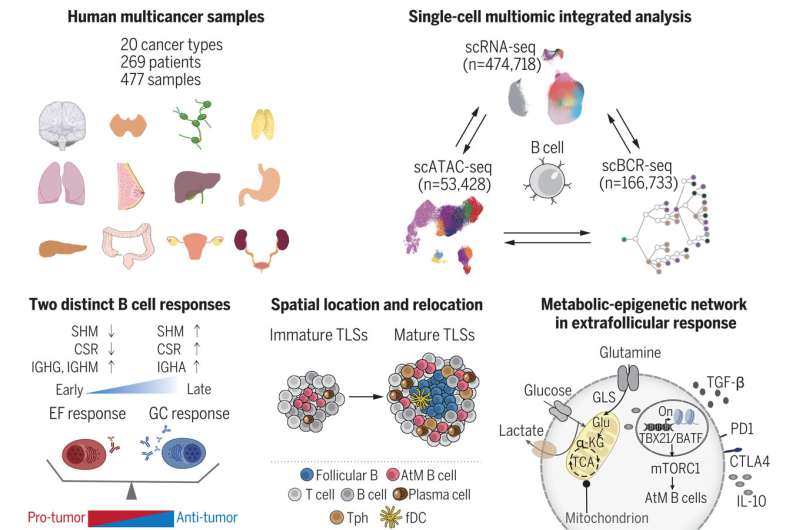
In a study published in Science on May 3, researchers unveiled two responding patterns of tumor-infiltrating B cells with therapeutic implications.
B cells have been long appreciated as an important component of tumor-infiltrating lymphocytes, but whether they play a positive or negative role in anti-tumor immunity is highly controversial.
In this study, with comprehensive single-cell multiomic analyses of B cells across 20 cancer types, the researchers classified the tumor-infiltrating B cell responses into germinal center (GC)-like and extra-follicular (EF), with cancer type preference.
The team included Prof. Zhang Xiaoming at the Shanghai Institute of Immunity and Infection (SIII) of the Chinese Academy of Sciences, Prof. Gao Qiang and Prof. Fan Jia at Fudan University, and Prof. Guo Guoji at Zhejiang University.
They found that the EF B cell response was associated with an immunosuppressive tumor microenvironment (TME) and unfavorable prognosis. In contrast, the GC-like B cell response was linked with a fertile anti-tumor immunity and favorable outcome.
In addition, through extensive analyses, the researchers determined the molecular feature and the differentiation pathway of the atypical memory (AtM) B cells (also called age-associated B cells, ABCs), the key player in the EF B cell response. Intriguingly, they found that the differentiation of AtM B cells could be promoted by glutamine metabolism, and the induced AtM B cells inhibited T cell functions and promoted Treg differentiation.
“It was unexpected that we identify a vicious role for AtM B cells within tumors, and this knowledge could open up new avenues for cancer immunotherapy by targeted dampening or depletion of AtM B cells,” said Prof. Zhang.
This study deepens the understanding of the heterogeneous roles of tumor-infiltrating B cells. It may provide new therapeutic opportunities for those cancer patients refractory to current immunotherapies, like hepatocellular carcinoma, which was dominated by EF B cell responses. With mechanistic insights and clinical validation, B-cell-targeted therapies may complement other types of immunotherapy in the near future.
More information:
Jiaqiang Ma et al, A blueprint for tumor-infiltrating B cells across human cancers, Science (2024). DOI: 10.1126/science.adj4857
Citation:
Study provides a blueprint of tumor-infiltrating B cells with therapeutic implications (2024, May 6)
blueprint-tumor-infiltrating-cells-therapeutic.html
.
. The content is provided for information purposes only.
